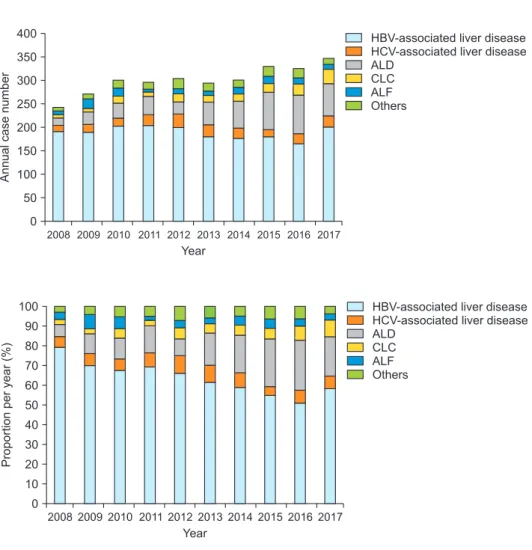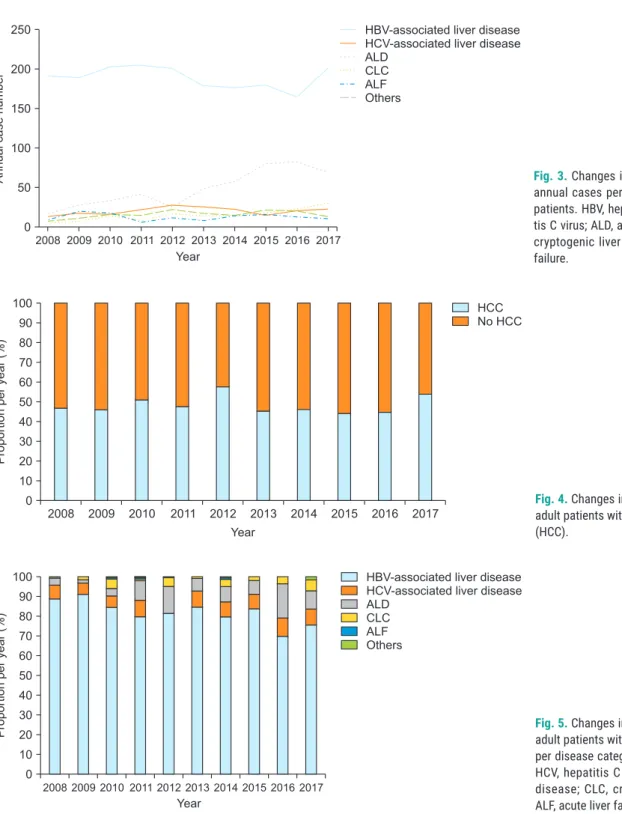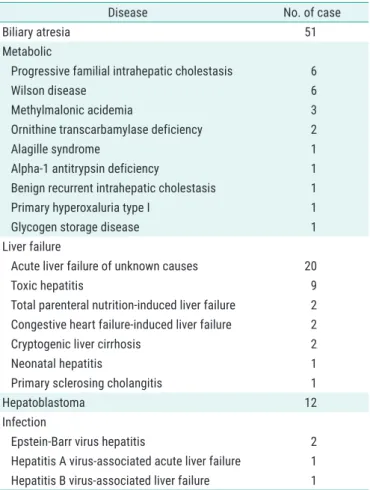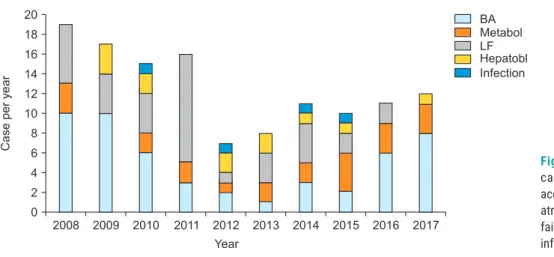Received August 9, 2019 Revised October 24, 2019 Accepted October 25, 2019 Corresponding author: Shin Hwang Department of Surgery, Asan Medical Center, University of Ulsan College of Medicine, 88 Olympic-ro 43-gil, Songpa- gu, Seoul 05505, Korea
Tel: +82-2-3010-3930 Fax: +82-2-3010-6701 E-mail: shwang@amc.seoul.kr
Changes in the indications for living donor liver transplantation: single-institution experience of 3,145 cases over 10 years
Sang-Hyun Kang, Shin Hwang, Chul-Soo Ahn, Ki-Hun Kim, Deok-Bog Moon, Tae-Yong Ha, Gi-Won Song, Dong-Hwan Jung, Gil-Chun Park, Jung-Man Namgoong, Young-In Yoon, Hui-Dong Cho, Jae-Hyun Kwon, Yong-Kyu Chung, Jin-Uk Choi, Sung-Gyu Lee
Department of Surgery, Asan Medical Center, University of Ulsan College of Medicine, Seoul, Korea
Background: To understand the changing demands and recent trends in the indications for living donor liver transplantation (LDLT), the present study aimed to analyze the indications for LDLT performed in a high-volume transplantation center over 10 years.
Methods: The liver transplantation database at our institution was searched to identify patients who underwent LDLT during a 10-year period from January 2008 to December 2017. The study subjects (n=3,145) were divided into two groups: adult patients (n=3,019, 92.7%) and pediatric patients (n=126, 3.9%).
Results: In the adult recipients, the primary diagnoses were hepatitis B virus (HBV)- associated liver cirrhosis (n=1,898, 62.9%), alcoholic liver disease (n=482, 16.0%), hepatitis C virus-associated cirrhosis (n=203, 6.7%), acute liver failure (n=127, n=4.2%), and other diseases (n=157, 5.2%). The mean Model for End-Stage Liver Disease score was 15.6±8.8 (range, 6–40). The proportion of patients with HBV-associated liver disease gradually decreased, but the proportion of those with alcoholic liver disease increased. Hepatocellular carcinoma (HCC) was diagnosed in 1,467 patients (48.6%). The mean proportion of patients with HCC was 63.1% among those with HBV- associated liver disease. In pediatric recipients, the primary diagnoses were biliary atresia (n=51, 40.5%), liver failure of various causes (n=37, 29.4%), metabolic disease (n=22, 17.5%), hepatoblastoma (n=12, 9.5%), and infectious diseases (n=4, 3.2%).
Conclusions: Our results showed that there were some significant changes in the indications of LDLT. We believe that our results may reflect the real changes in the indications of LDLT and they will be useful for predicting further changes in the future.
Keywords: Living donor liver transplantation; Hepatitis B virus; Liver cirrhosis; Pediatric transplantation; Biliary atresia
© The Korean Society for Transplantation This is an Open Access article distributed under the terms of the Creative Commons Attribution Non-Commercial License (http://creativecommons.org/licenses/
by-nc/4.0/) which permits unrestricted non-commercial use, distribution, and reproduction in any medium, provided the original work is properly cited.
pISSN 2671-8790 eISSN 2671-8804
INTRODUCTION
Liver transplantation (LT) is the established treatment for a variety of end-stage liver diseases. In countries with a shortage of deceased donors, living donor liver transplan- tation (LDLT) is performed as the main type of LT. In Korea, the most common indication for LT in adults is hepatitis B virus (HBV)-associated liver cirrhosis, whereas alcoholic liver cirrhosis and hepatitis C virus (HCV)-associated liver cirrhosis are the main indications of LT in Western coun- tries. However, aggressive antiviral treatments for both HBV and HCV have recently been introduced, which has led to significant changes in the distribution of various LT indications in Korea. Furthermore, the Model for End- Stage Liver Disease (MELD) score was recently adopted to allocate deceased donor livers for transplantation, so noticeable changes have occurred in the indications for deceased donor LT (DDLT) as well. Specifically, the num- ber of alcoholic liver disease (ALD) cases undergoing DDLT has markedly increased. In pediatric patients under 12 years of age, the Pediatric End-Stage Liver Disease (PELD) score is used [1-4].
However, few data are currently available regarding the recent changes in indications for LDLT in Korea, even though clinicians may benefit from a better understanding of the changing demands and recent trends in the indica- tions for LDLT in adult and pediatric patients. Therefore, in the present study, we aimed to analyze the institu- tional data regarding indications for LDLT performed in a high-volume transplantation center over 10 years.
METHODS
The protocols of this retrospective cohort study were approved by the Institutional Review Board of the Asan
Medical Center (IRB No. 2018-0739).
The LT database at our institution was searched to identify patients who underwent LT during a 10-year pe- riod from January 2008 to December 2017. Only LDLT cases were included in the present study, because DDLT rates were greatly influenced by the annual incidence of deceased donors and the recent adoption of MELD score-
Table 1. Indications for living donor liver transplantation in 3,019 adult patients
Disease No. of cases
Hepatitis B virus infection 1,898
Hepatitis C virus infection 203
Alcoholic liver disease 236
Cryptogenic liver cirrhosis 152
Acute liver failure 123
Others Cholestatic
Primary sclerosing cholangitis 29
Primary biliary cirrhosis 27
Secondary biliary cirrhosis 18
Biliary atresia 3
Vanishing bile duct syndrome 1
Vascular
Budd-Chiari syndrome 11
Portal biliopathy 1
Metabolic
Wilson disease 15
Citrullinemia type III 2
Amyloidosis 1
Glycogen storage disease 1
Hemosiderosis 1
Hepatocellular
Autoimmune hepatitis 27
Non-alcoholic steatohepatitis 1
Cytomegalovirus hepatitis 1
Neoplastic
Epithelioid hemangioendothelioma 4
Perihilar cholangiocarcinoma 1
Intraductal papillomatosis 1
Neuroendocrine tumor 1
Intraductal papillary biliary neoplasm 1 Unclassified
Polycystic liver disease 6
Congestive heart failure-induced liver failure 2
Caroli disease 1
Cavernous hemangioma 1
HIGHLIGHTS
• This study aimed to analyze the indications for living donor liver transplantation performed in a high-volume transplantation center over 10 years.
• There were some significant changes in the indications,
such as decrease in hepatitis B virus-associated liver
disease and increase in alcoholic liver disease.
based allocation. Retransplantation cases were excluded to avoid unnecessary bias.
The study patients (n=3,145) were divided into two groups: adult patients (age ≥18 years; n=3,019, 92.7%) and pediatric patients (age <18 years; n=126, 3.9%). Only those diagnosed with hepatocellular carcinoma (HCC) before their LT were defined as patients with HCC, while patients with incidental HCC in the explanted livers were excluded from the analysis. Since HCC on a background of chronic liver disease cannot be categorized as either HCC or chronic liver disease, these two diseases were analyzed separately. Descriptive statistical analyses were performed using IBM SPSS ver. 22.0 (IBM Corp., Armonk, NY, USA).
RESULTS
The overall profiles of the 3,019 adult patients are sum-
marized in Table 1. The number of cases of each disease was as follows: HBV-associated liver disease, 1,898 (62.9%); ALD, 482 (16.0%); HCV-associated liver disease, 203 (6.7%); acute liver failure, 127 (4.2%); and other dis- eases, 157 (5.2%). The mean MELD score was 15.6±8.8 (range, 6–40).
The annual numbers of adult LDLT cases over the 10- year study period, according to the primary indications, are depicted in Fig. 1. The overall number of adult LDLT cases gradually increased over the 10 years. The pro- portion of cases involving HBV-associated liver disease gradually decreased, while the proportion involving ALD noticeably increased (Figs. 2 and 3).
HCC was diagnosed in 1,467 patients (48.6%) before the LDLT operation. The annual proportion of HCC cases among all adult LT procedures fluctuated between 44.4%
and 54.0% (Fig. 4). The proportion of annual cases for each disease category among patients undergoing LDLT with HCC is depicted in Fig. 5. After isolating the patients with HBV-associated disease, the annual proportion of
2008 2009 2010 2011 2012 2013 2014 2015 2016 2017 400
350 300 250 200 150 100 50
Annualcasenumber
Year 0
HBV-associated liver disease HCV-associated liver disease ALD
CLC ALF Others
Fig. 1. Cumulative incidences of annual case numbers in adult patients according to the six categories. HBV, hepatitis B virus-associ- ated liver disease; HCV, hepatitis C virus-as- sociated liver disease; ALD, alcoholic liver disease; CLC, cryptogenic liver cirrhosis; ALF, acute liver failure.
2008 2009 2010 2011 2012 2013 2014 2015 2016 2017 100
90 80 70 60 50 40 30 20 10
Proportionperyear(%)
Year 0
HBV-associated liver disease HCV-associated liver disease ALD
CLC ALF Others
Fig. 2. Changes in the proportions of annual cases per disease category in adult patients.
HBV, hepatitis B virus-associated liver dis- ease; HCV, hepatitis C virus-associated liver disease; ALD, alcoholic liver disease; CLC, cryptogenic liver cirrhosis; ALF, acute liver failure.
patients with HCC also fluctuated from 52.6% to 71.2%, with a mean value of 63.1% (1,198/1,898) (Fig. 6).
In 126 pediatric patients, the primary indications for LDLT are summarized in Table 2, in which the number of cases of each disease was as follows: biliary atresia, 51 (40.5%); liver failure of various causes, 37 (29.4%); met-
abolic disease, 22 (17.5%); hepatoblastoma, 12 (9.5%);
and infectious diseases, 4 (3.2%). HCC was identified in two patients (1.6%). The annual case number of pediat- ric LDLT according to the primary indications over the 10 years are depicted in Fig. 7. The mean PELD score was 22.1±9.4 (range, 6–40).
2008 2009 2010 2011 2012 2013 2014 2015 2016 2017 250
200
150
100
Annualcasenumber 50
Year 0
HBV-associated liver disease HCV-associated liver disease ALD
CLC ALF Others
Fig. 3. Changes in the number of individual annual cases per disease category in adult patients. HBV, hepatitis B virus; HCV, hepati- tis C virus; ALD, alcoholic liver disease; CLC, cryptogenic liver cirrhosis; ALF, acute liver failure.
2008 2009 2010 2011 2012 2013 2014 2015 2016 2017 100
90 80 70 60 50 40 30 20 10
Proportionperyear(%)
Year 0
HCC No HCC
Fig. 4. Changes in the annual proportions of adult patients with hepatocellular carcinoma (HCC).
2008 2009 2010 2011 2012 2013 2014 2015 2016 2017 100
90 80 70 60 50 40 30 20 10
Proportionperyear(%)
Year 0
HBV-associated liver disease HCV-associated liver disease ALD
CLC ALF Others
Fig. 5. Changes in the annual proportions of adult patients with hepatocellular carcinoma per disease category. HBV, hepatitis B virus;
HCV, hepatitis C virus; ALD, alcoholic liver disease; CLC, cryptogenic liver cirrhosis;
ALF, acute liver failure.
DISCUSSION
Over the study period of 10 years, the annual number of LDLT cases gradually increased. The common indica- tions for LDLT remained unchanged, but their proportions
changed according to the changing demand. The increas- ing incidence of deceased donors and adoption of MELD score-based liver allocation also affected the real-world demand for LDLT in the present study [1-5].
In Korea, the most common indication for adult DLLT for a long time has been HBV-associated liver disease.
HCC often develops in patients with this disease, so a diagnosis of HCC often prompts the decision to perform LDLT. In the present study, 63.1% of patients with HBV-as- sociated liver disease had been diagnosed with HCC at the time of LDLT. Most of them had relatively low MELD score, usually less than 20, because they wanted to receive LDLT early, before progression to liver cirrhosis or more ad- vanced HCC [6-8].
In our analysis, the most noticeable change was the progressive increase in the proportion of patients with ALD. In 2008, only 6.6% of patients (16/243) undergo- ing LDLT had ALD, but this gradually increased to 19.8%
(69/348) in 2017. These results indicate that ALD is now regarded as an legitimate indication for LDLT in Korean so- ciety. After the adoption of MELD score-based allocation in Korea in June 2016, the proportion of patients receiv- ing DDLT who had ALD significantly increased, because most of them had very high MELD scores of category 2 (MELD score ≥38) or upper category 3 (MELD score ≥35) [2-4]. We presume that such ALD patients have very high MELD score mainly because they often continue drinking until the terminal stage, and because they are neglected by family members and fail to maintain basic activities of daily living. In contrast, patients with ALD undergoing LDLT have a relatively favorable general condition, as well as a relatively long abstinence period [9-11].
In more recent years, we encountered patients with HCV-associated liver disease more frequently than be-
2008 2009 2010 2011 2012 2013 2014 2015 2016 2017 100
90 80 70 60 50 40 30 20 10
Proportionperyear(%)
Year 0
HCC No HCC
Fig. 6. Changes in the annual proportions of adult patients with hepatocellular carci- noma (HCC) among those with hepatitis B virus-associated liver disease.
Table 2. Indications for living donor liver transplantation in 126 pediatric patients
Disease No. of case
Biliary atresia 51
Metabolic
Progressive familial intrahepatic cholestasis 6
Wilson disease 6
Methylmalonic acidemia 3
Ornithine transcarbamylase deficiency 2
Alagille syndrome 1
Alpha-1 antitrypsin deficiency 1
Benign recurrent intrahepatic cholestasis 1
Primary hyperoxaluria type I 1
Glycogen storage disease 1
Liver failure
Acute liver failure of unknown causes 20
Toxic hepatitis 9
Total parenteral nutrition-induced liver failure 2 Congestive heart failure-induced liver failure 2
Cryptogenic liver cirrhosis 2
Neonatal hepatitis 1
Primary sclerosing cholangitis 1
Hepatoblastoma 12
Infection
Epstein-Barr virus hepatitis 2
Hepatitis A virus-associated acute liver failure 1 Hepatitis B virus-associated liver failure 1
fore [12,13]. Contrary to our expectation, the proportion of patients with HCV-associated liver disease had not in- creased noticeably. We suggest two potential reasons for this: (1) that the increase in LDLT recipients with HCV-as- sociated liver disease was more marked in recent years than during the study period and (2) that many patients with HCV receiving direct-acting antiviral agent became seronegative, which might lead to a decrease in advanced liver cirrhosis.
With the increase in the incidence of deceased donors, the need for urgent LDLT in patients with acute liver failure has decreased [14]. Furthermore, adoption of MELD score- based allocation gives organ allocation priority to patients with high MELD score [2-5]. However, in the present study, highly urgent LDLT had to be performed in some patients with rapidly deteriorating fulminant hepatic failure, be- cause the timing of DDLT allocation is usually unpredict- able. Until the incidence of deceased donors increases markedly in Korea, LDLT will still be necessary in highly urgent cases.
Pediatric LT is more influenced by the incidence of de- ceased donors than in adult LT, because the pool of pedi- atric recipient candidates is small and the chance of split LT is high. Adoption of PELD score might not lead to sig- nificant changes in pediatric LT, probably because there is no shortage of deceased donors permitting liver splitting relative to the pool size of pediatric candidate recipients [2,15-17].
Many patients with metabolic diseases other than Wilson’s disease have not benefited from the adoption of MELD/PELD score, because no exceptions to MELD score are permitted in the current Korean deceased donor liver allocation system. Many pediatric patients with metabolic diseases show low PELD scores, even when their condi-
tion is deteriorating, so the parents of such pediatric pa- tients must elect to perform LDLT [2,15].
LDLT to treat neoplastic diseases other than HCC has sporadically been performed in our institution. Epithelioid hemangioendothelioma and hepatoblastoma are estab- lished eligible indications for adult and pediatric LT, re- spectively [18-21]. Some studies have used LDLT to treat perihilar cholangiocarcinoma [22-24], which we do not regard as an eligible indication for LDLT because it entails a high risk of tumor recurrence.
Our high-volume experience of LDLT constituted ap- proximately one-third of Korean LDLT cases nationwide.
Thus, our results likely reliably reflect the real-world sit- uation regarding LDLT in Korea. Indeed, we performed this study mainly because data are still lacking regarding recent changes in indications for LDLT. A collection of sim- ilar high-volume studies from the other major Korean LT centers will be helpful to visualize the landscape of LDLT in Korea.
There were some limitations in the present study. It was a retrospective, single-center study, although the sam- ple number was large enough to perform analysis. Further- more, DDLT and retransplantation cases were excluded to avoid unnecessary bias. To generalize our results, nation- wide multi-center studies are necessary.
In conclusion, our results showed that there were some significant changes in the indications for LDLT. The proportion of patients with HBV-associated liver disease gradually decreased over the 10-year study period, while that of patients with ALD increased. Half of the adult LDLT recipients had HCC, indicating that LDLT is accepted as an established treatment for HCC. We believe that our results may reflect real changes in the indications for LDLT and that they will be useful for predicting further changes in
2008 2009 2010 2011 2012 2013 2014 2015 2016 2017 20
18 16 14 12 10 8 6 4 2
Caseperyear
Year 0
BA Metabol LF Hepatobl Infection
Fig. 7. Cumulative incidences of annual case numbers among pediatric patients according to the five categories. BA, biliary atresia; Metabol, metabolic disease; LF, liver failure; Hepatobl, hepatoblastoma; Infection, infectious disease.
the near future.
ACKNOWLEDGMENTS
Conflict of InterestNo potential conflict of interest relevant to this article was reported.
Funding/Support
This study was supported by the intramural research fund of Asan Medical Center Organ Transplantation Center and was supported by research grant from the Korean Society for Transplantation (2020-01-01003-008).
ORCID




